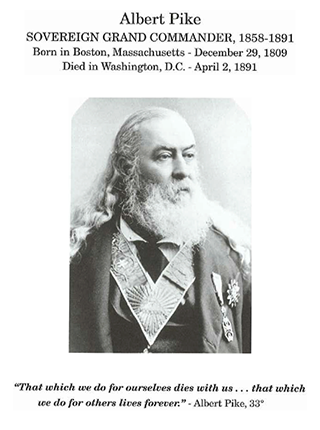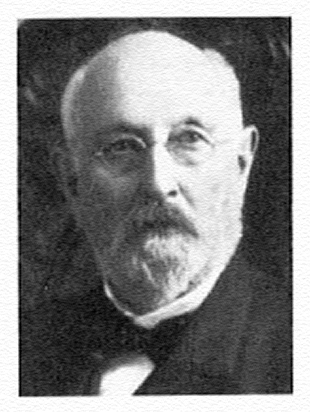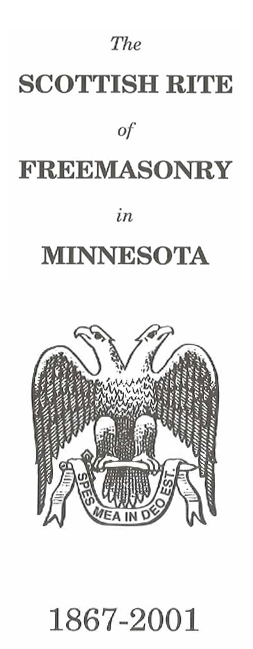– Excerpt from “The Scottish Rite of Freemasonry in Minnesota, 1867-2001”
In 1869 a few men who had received the degrees of the Scottish Rite in various places across the nation moved to Minneapolis. The Scottish Rite, already established in St. Paul, began in Minneapolis when Brother Alfred Elisha Ames took the first steps necessary to organize a new Valley.
Brother Alfred Elisha Ames, who moved to Minnesota in 1851, hosted the first Craft Lodge meeting in Minneapolis in his old “claim shanty.” He was an active member of his Blue Lodge and York Rite bodies, and served as the first Grand Master of Masons of Minnesota. He received the honorary Thirty-third degree in 1854 in the Northern Jurisdiction, complicating his relationship with the Southern Jurisdiction. But fairness prevailed and he was deputized by the Sovereign Grand Commander, who soon recommended him for active membership in the Southern Jurisdiction Supreme Council. Albert Pike said, “[Ames] cordially united with me in my efforts to initiate reform, and has established at Minneapolis a flourishing Lodge of Perfection, and after due delay a Chapter of Rose Croix… We have no more earnest, devoted, and intelligent workman in the jurisdiction than Illustrious Brother Ames.”
Sterling Young McMasters, Deputy and Legate for the State of Minnesota, issued a letter, dated April 2L, 1873, declaring Ames as his Deputy in the City of Minneapolis and authorizing Ames to organize Bodies and confer degrees not above the 30th. Ames conferred the 14th degree upon several Brothers between May 24 and June 6, 1873. On June 9, 1873, eleven Perfect EIus and two Masters of the Royal Secret (associated from St. Paul) signed a petition for a Lodge of Perfection in Minneapolis.
Sovereign Grand Commander Albert Pike issued letters of Patent on June 23, 1873 and assigned the name Excelsior for the new Lodge of Perfection. On Thursday evening, February 10, 1874, Illustrious Brother Ames installed the first elected and appointed officers of Excelsior Lodge of Perfection No. 3.
In those early days the active membership in a Lodge of Perfection was limited to 27, and members above that number were termed “honorary” members. This limitation was removed shortly after the Minnesota charter was granted.
On December 13, 1873, Illustrious Brother Ames constituted Saint Vincent de Paul Chapter of Rose Croix No. 1 and installed its first officers. This was the first Chapter of Rose Croix in the state. A Council of Princes of Jerusalem (15° and 16°) had been instituted in St. Paul, but no Chapter had been formed there. The first four candidates in Minneapolis were advanced to the Eighteenth Degree on Maundy Thursday, April 2, 1874.
An interesting sidelight on the character of Brother Ames appears in the record of the first formal meeting of the new Chapter. It was the practice for each Knight Rose Croix to select a name exemplifying “one of the attributes of a Knight or Mason . . . by which he is ever afterward to be known.” Brother Ames selected “Zeal” and it seems that all who knew him must have appreciated the appropriateness of the selection.
Illustrious Brother Alfred Elisha Ames died on September 23, 1874 and the rest of the decade became a time of struggle and discouragement for the Minneapolis Valley. Brother Giles Merrill,32″, of St. Paul, Deputy of the Supreme Council during 1869-1882, assumed the duties of Special Deputy for Minneapolis.
Brother Merrill was a worthy representative, but he was too busy to devote much time to the affairs of the Minneapolis Valley. In 1880 Excelsior No. 1 sent a petition to the Supreme Council requesting remission of dues, suggesting major financial difficulties. No returns from the Minneapolis Bodies were recorded in the Transactions of the Supreme Council, 1878, though there is mention of some communication sent from Minneapolis by way of Brother Merrill. Later it is clear that the dues were paid.

In 1879 Grand Commander Albert Pike visited the Twin Cities, but found that in Minneapolis “a quorum could not be brought together” to give him official reception and honors. He did, however, confer the Thirty-second Degree on five or six men. Earlier that same year, Grove B. Cooley, as Deputy of the Supreme Council, conferred the Thirty-second degree on an additional five or six men.
In spite of the general inactivity, some meetings were held and some work was done. It was the custom to confer the Fourth, Fifth and Ninth Degrees, communicating the rest,
and then have a special session for conferring the Fourteenth Degree. Practically the activity in the Minneapolis Bodies was minimal from 1875 to 1880.
It is a matter of pride that the Chapter of Rose Croix never gave up entirely. While there was no apparent effort to maintain a monthly meeting schedule or confer degrees, the brethren maintained fraternal fellowship and met at least once every yet. On several occasions they met to conduct a Maundy Thursday ceremony. Dues and donations were usually sufficient to cover the expenses, but in 1880 the Wise Master paid a considerable deficit from his own pocket. (This was repaid at a later meeting by a collection from the brethren.) These meetings and ceremonies were truly the only fraternal life of the Minneapolis Valley for several years. The record of this struggle for existence was generally prevalent throughout the southern jurisdiction at this time. Brother Albert Enos Higbee moved to Minneapolis in about 1879 and the Minneapolis Bodies all paid tribute to him as a tireless, enthusiastic worker who loved the Scottish Rite and roused the brethren to resume active work. Doctor Higbee had been a member of three bodies in St. Paul before his move to Minneapolis. Once here he made himself known and, after some favorable communications with the Supreme Council, in L880 he called a meeting at his office, resulting in a new lease on life for the Minneapolis Valley. Since then it has never faltered.
Alfred Elisha Ames Preceptory of Kadosh was organized in early 1880, with twelve Thirty-second Degree and three Thirtieth Degree members signing the petition. A number of communications from the Supreme Council between January and April of 1880 discussed the requirements for forming a Consistory in Minneapolis. The first degree work of the new Consistory was recorded on March 11, 1881 when Brothers D.M. Goodwin and A.E. Higbee were consecrated Masters of the Royal Secret.
It was not until 1882 that a Minnesotan was crowned an active Thirty-third Degree for Minnesota, when Robert Strachan Innes of Minneapolis became Inspector General. A gala occasion in 1882 was the Maundy Thursday banquet. Notes of the affair, a full list of officers and members of St. Vincent de Paul Chapter, and the program for the ceremony are contained in the Official Bulletin of the Supreme Council, Vol. V, pp. 378-379.

A significant accompaniment to the turmoil and revival during this period was the arrival of Brother Samuel “Uncle Sam” Emery Adams. “Uncle Sam” was a farmer at Monticello, a school teacher, an alderman for the Fourth Ward in Minneapolis, and nationally known for his work in the Grange and the Scottish Rite. Brother Adams received the Scottish Rite degrees from A.T.C. Pierson in 1866. In l-878 he withdrew from the St. Paul Valley and affiliated with the Minneapolis Valley in 1880. When Albert Pike visited Minnesota in 1885, he crowned Adams a Thirty-third degree Mason. The following year Pike appointed Adams Inspector General for Minnesota and active member of the Supreme Council in 1886. The Transactions of the Supreme Council, 1912-1913 paid him tribute by saying: “He saw the Rite [in Minnesota] grow under his charge from about 60 members to about 2,700 members. Its satisfactory condition and progress is due to him more than to any other person.”
Download the entire book on PDF here:
“The Scottish Rite of Freemasonry in Minnesota, 1867-2001”
